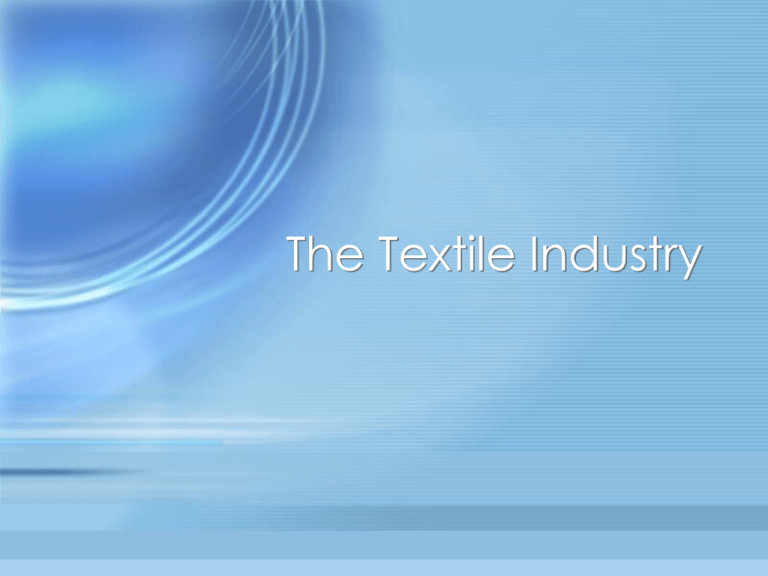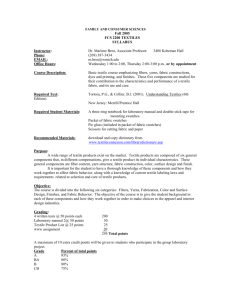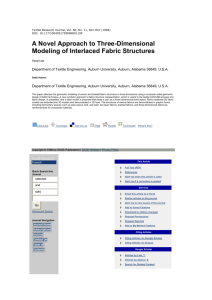The Textile Industry - Kecoughtan Marketing
advertisement

The Textile Industry Objectives • To understand the textile industry as the primary material source for the apparel, interior furnishings, and industrial products industries • To know the various segments of the textile industry • To be able to follow the channels of distribution of textile products • To be aware of the careers requiring a professional knowledge of textiles General Fields of Textile Products • Three Large Groupings – Apparel • Textiles used in clothing – Interior Furnishings • Textiles used in furniture, bath, kitchen and bed – Industrial • Textiles used in luggage, flags, boat sails, gauze, bandages, dust filters, and so on Major Textile Production Segments • Fibers • Yarns • Fabrics • Dyeing and Printing • Finishing • Textile Put-Up Fibers • The smallest part of the fabric • Fine, hair-like substances, categorized as either natural or manufactured • Cotton and wool are natural fibers • Acrylic, nylon and polyester are manufactured fibers Yarns • Continuous thread-like strands composed of fibers that have been twisted together • There are various types of yarn, from flat and dull to slubby and lustrous Fabrics • Made from yarns and are either woven or knitted • Springs Industries and Milliken & Company are two of the largest U.S. mills • The range of fabric types and weights is tremendous, fulfilling a variety of consumer demands Dyeing and Printing • Color is usually applied to the woven or knitted fabric by either dyeing or printing • Dyeing is the process for imparting a solid color to textiles • Printing is the process of imparting designs to textiles • The purpose is to make the fabric more appealing Finishing • Most fabrics need additional treatments called finishes before they can be used • For example, special chemicals are used to make a fabric waterrepellent and suitable for a raincoat Textile Put-Up • Put-up is the term used to indicate the way fabric is packaged when it is sold • Most fabrics sold to garment and other manufacturers are in a rolled put-up, where the fabric is wound around a cardboard tube Primary Sources of Fabric • Mills – A company that owns textile machinery and makes fabric • Converters – An individual or organization that buys greige goods (that is, unfinished fabric) • Importers – Direct Importer buys fabric or manufactured textile products – Import Mill is a foreign company that owns machinery and makes the fabric and then exports it to the US Secondary Sources of Fabric • Jobbers – Buys from mills, converters, and garment manufacturers • Retail Stores – Home sewers purchase fabrics sold in retail stores • Overseas Agents – A person or company that represents an exporter or importer in the countries overseas where it conducts business Buying and Selling Fabric • Fabrics are purchased either according to written specifications or from a sample • If it is according to specifications it must be exact. • Specifications: yarns per inch, width, weight, thickness, breaking strength and degree of colorfastness • If fabric is purchased from a sample, the seller is required to deliver a fabric almost identical to the sample Buying and Selling Fabric • Fabric is sold either as greige or as finished fabric • Frequently fashion designers or other end-product designers work closely with textile mill designers to create specific fabrics to meet their needs Private Label • Very large quantities of textiles are sold directly to department stores, mail order houses, or discount chains for manufacture by the retailer or a contractor into private label clothing • A private label is a retail brand in which apparel or other sewn products are manufactured specifically for a retailer and sold exclusively by that retailer Market and Production Planning • Each segment of the textile industry must plan well ahead of the next selling season • Unless schedules are maintained and deadlines met by the fiber producers, fabric mills, and other textile companies, it may not be possible to ship products when the buyers are ready to buy Seasons • The two main selling seasons for apparel are fall and spring • Fall season starts around August 1 • Spring season starts February 1 • The other seasons are summer and holiday Environmental Problems • Air and water pollution • Disposal of waste products • Health of workers in mills • Possible water pollution from home laundering Recycling • Recycling must be an integrated effort between consumers, retailers, manufacturers, recyclers and the government • Recycled products include fibers, yarns, fabric, garments, and used chemicals International Trade Shows • Interstoff - (Fabric Exposition) • SEHM - The Salon International de l’Habillement Masculin - (Men’s and Boys Fashions) • Techtextil - (Technical Textiles) • Heimtextil - (Home Textiles) • ITMA - International Exposition of Textile Machinery Domestic Trade Shows • ATME - American Textile Machinery Exhibition • IFFE - International Fashion-Fabric Exposition • Magic Internations (Men’s Apparel) Textile Careers • Nearly every country in the world is involved with textiles • Requires areas such as design, creative talents, technology, merchandising and management • Combines art, structured engineering, technical styling, marketing, and business Textile Careers • Administrative Assistant • Consultant • Converter • Coordinator • Education • Environmental Protection • • • • • • • • Forecasting Museum Curator Production Public Relations Quality Assurance Reporter Sales Sourcing









